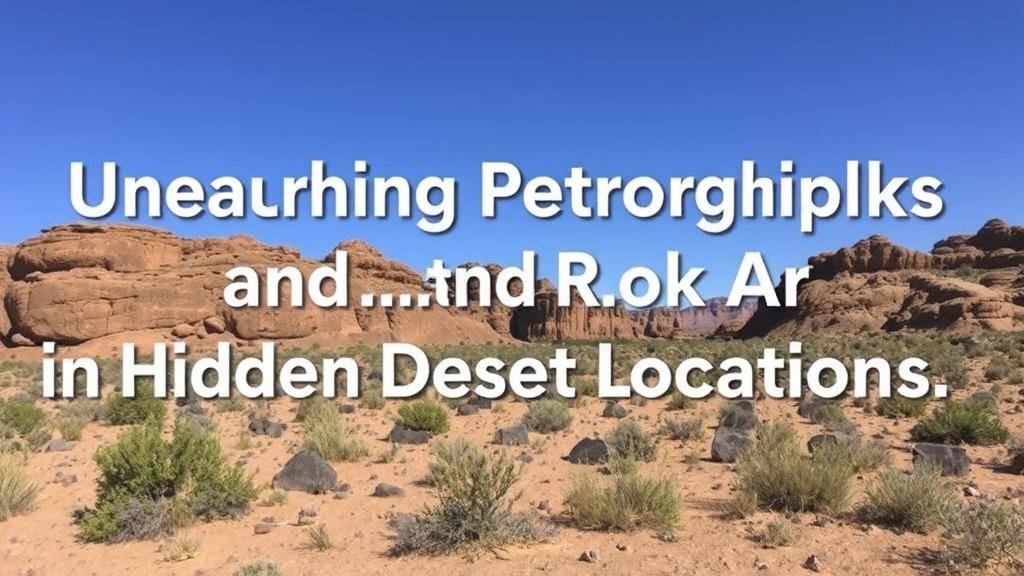Unearthing Petroglyphs and Rock Art in Hidden Desert Locations
Unearthing Petroglyphs and Rock Art in Hidden Desert Locations
Petroglyphs and rock art serve as a profound link to historical cultures, revealing insights into the lives, beliefs, and environments of ancient peoples. Found extensively in desert landscapes across the globe, these artworks offer a fascinating glimpse into human expression through time. This article explores the significance, methods, and real-world implications of unearthing petroglyphs and rock art in remote desert locations.
The Importance of Petroglyphs and Rock Art
Petroglyphs–images carved into rock surfaces–alongside painted rock art, provide crucial information about prehistoric life, including social structures, spiritual beliefs, and environmental interactions. A few notable examples include:
- The famous petroglyphs of Californias Channel Islands, which depict marine life and human figures, suggest a deep relationship between the inhabitants and their environment.
- The rock art of the American Southwest, like that found in Utahs Nine Mile Canyon, demonstrates ritual practices and possibly even territorial markings.
These art forms not only allow researchers to study ancient cultures, they also help contemporary societies understand their heritage and continuity. Ethnographic studies have shown that many modern Native American tribes utilize the symbolism found in these artworks in cultural practices today.
Methods of Discovery
Unearthing petroglyphs and rock art in hidden desert locations involves various methods, often employing both traditional archaeological techniques and modern technology. Key methods include:
- Field Surveys: Archaeologists conduct visual surveys of desert landscapes, searching for rock outcrops that may contain petroglyphs.
- Remote Sensing: Technologies such as LiDAR (Light Detection and Ranging) are increasingly utilized, allowing researchers to map landforms and identify potential sites without invasive digging.
- Photography and Digital Mapping: High-resolution imaging and 3D modeling provide potential for detailed analyses without the need for physical contact, thus preserving fragile artworks.
A case in point is the use of drone technology to capture aerial images of remote desert regions, which has enabled the identification of previously undocumented petroglyphs in places like the Great Basin in Nevada.
The Challenges of Conservation
While the discovery of petroglyphs and rock art is exhilarating, archaeological teams face numerous challenges when it comes to conservation. delicate nature of these artworks necessitates careful handling, as many threats are present:
- Natural Erosion: Wind, rain, and temperature fluctuations can gradually wear away these ancient records.
- Vandalism: Unfortunately, human activities such as graffiti and reckless tourism often lead to irreversible damage.
- Climate Change: Increased temperatures and shifting weather patterns can alter the landscapes housing these artworks, potentially leading to loss or destruction.
For example, the petroglyphs at the Petroglyph National Monument in New Mexico have faced serious degradation due to increased foot traffic and environmental factors. Conservation efforts, including fencing off sensitive areas and educational programs, aim to protect these cultural treasures.
Real-World Applications
Understanding petroglyphs and rock art transcends academic interest. It has practical implications for modern governance, tourism, and cultural awareness. For example, the Tusayan Ruins and Museum adjacent to the Grand Canyon offer insights into both the ancient Native American lifestyles and current tribal governance structures.
Incorporating rock art into tourism raises awareness and fosters respect for indigenous cultures. Responsible tourism initiatives prioritize preserving these sites while sharing their significance, leading to sustainable engagement with both local communities and visitors. Viable examples include:
- Guided tours that educate tourists about the historical and cultural contexts of the art.
- Workshops with indigenous artists that teach traditional craftsmanship and storytelling.
Actionable Takeaways
For those interested in contributing positively to the study and preservation of petroglyphs and rock art, consider the following:
- Participate in local archaeology volunteer programs aimed at recording and protecting rock art sites.
- Advocate for responsible tourism practices when visiting sensitive archaeological sites.
- Support institutions and museums that promote research and conservation efforts of ancient cultures.
To wrap up, unearthing petroglyphs and rock art in hidden desert locations provides invaluable insights into our shared human history. By utilizing innovative methods of discovery, addressing conservation challenges, and applying real-world implications, we can foster a future that respects and preserves these remarkable cultural legacies.



